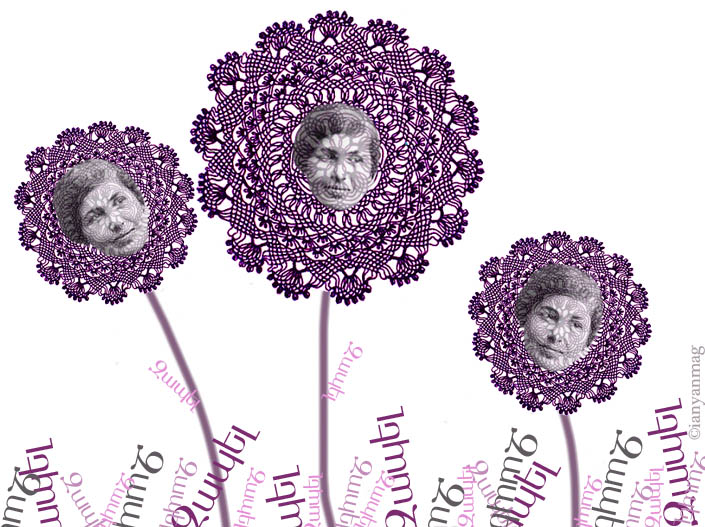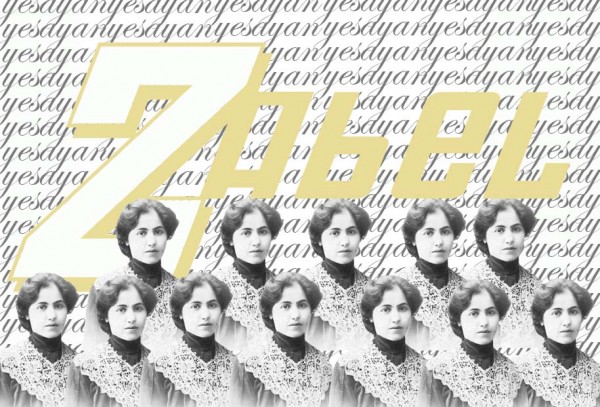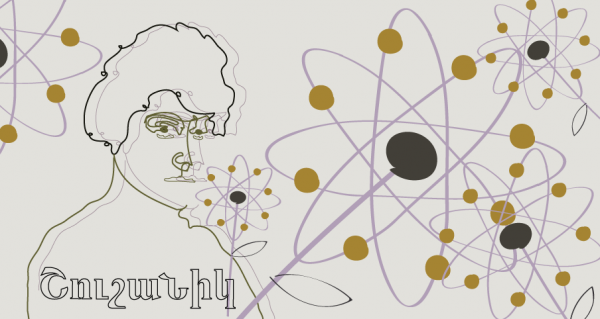Roundup: In Honor of International Women’s Month

All of last month, we invited contributors to submit their prose, photography, translations and stories in honor of International Women’s Day and Month. The response was amazing – from an interview with writer Nancy Agabian, to a heartfelt essay honoring the memories of a grandmother and two original translations of Armenian work – including an exclusive, never been before published English version of a Shushan Kurghinian poem. In case you missed our series, we’ve highlighted them below for your reading pleasure, along with original ianyanmag illustrations.
Thank you to all who contributed, read and positively propelled the badly needed dialogue when it comes to women’s issues, especially in the South Caucasus and all over the world.

Armenian writer Zabel Yesayan/ Illustration © ianyanmag
- Nancy Agabian on Growing up Queer, Feminism and Armenia , by Nora Kayserian. “Growing up in a predominantly white town in the 70s and 80s, I held a lot of shame and self-hatred for being Armenian,” writer Nancy Agabian tells Nora Kayserian. “Writing helped me through this. In particular, writing among a multicultural group of people made me realize how much Armenians’ history of oppression was important – that it told an important human truth that others could relate to and learn from.”
- In Armenia, Gender Discrimination Just a Scratch Beneath the Surface, by Victoria Rovira Infante. ” When I want to understand the problems caused by sexual inequality in Armenia,” writes Armenia resident Victoria Rovira Infante, “there’s no longer any need for me to read shocking stories about bride-napping, red apple ceremonies, and sex-selective abortions in remote villages, or about the miserable state of sex education in schools, employer discrimination against married and pregnant women, and the low visibility of women in politics right here in the capital. I already know. As an outsider looking in, even I am not completely safe from the far-reaching claws of bigotry in my everyday life. I know it when men, thinking they are being polite, treat me as weak or inferior.”
- Documenting the Lives of Women in Armenia, by Emily Haas, Paige Prince and Henni Alpermann. Three volunteers in Armenia embark on a fascinating project to document the lives of the women around them through photography. One of them is Emma. “When she tells us about her son’s death at the age of 30, she has still tears in her eyes, 18 years later,” they write. “She cannot see very well, she says, ‘The world is cloudy to me.’ With patience is she sitting on her bed and waiting until we have the right picture. She smiles and tells us openly about their life. She is originally from Getap village, married a man from the same village and has stayed there her whole life. Everybody in the village knows her and appreciates her open-minded, friendly character.”

Armenian writer Zabel Yesayan/ Illustration © ianyanmag
- A Look Back at Soviet-Era International Posters Our slideshow of Soviet propaganda posters featuring those created in honor of International Women’s Day.
- Op-Ed: In Armenian Nation, Men Must Take On Gender Equality , Guest Author, Saro. “Just like women, men are prisoners of their own complex,” writes Saro, commenting on gender inequality in Armenia and advocating for men to step up to enhance the discussion around it. “This power imbalance has created an unequal system where women have been regulated as cogs in a machine.”
- Exclusive: Shushanik Kurghinian’s “The Workers,” by Shushan Avagyan. Literary translator, who is working on her PhD on comparative literature at Illinois State University sent in an never-before-published English translation of Shushanik Kurghinian’s poem, “The Workers.”

Armenian poet Shushanik Kurghinian/ Illustration © ianyanmag
- The View from Zabel Yesayan’s The Gardens of Silihdar, Part I, by Jennifer Manoukian. “She said that Armenian society as it is now is not yet ready for a woman for make a name and place for herself. To overcome these obstacles, you must overcome mediocrity: a man can be mediocre, a woman cannot.” Our women’s series continues with an exploration into the obstacles French and Armenian writers faced in the 19th century through the eyes of Zabel Yesayan. Check out Part II here.
- Op-Ed: For Women, the Work Behind the Beauty, by Nathalie Nourian. “As a people of the mountainous Caucasus region, we are a hairy bunch,” writes Nathalie Nourian on the routines women must endure to look socially presentable. “Unfortunately, evolution has not yet caught up with us and we’ve still got a generous pelt of protective hair to help against the elements, since, you know, clothes just aren’t enough.”
- Pineapples & Lezhankas: Memories of my Grandmother, by Janet Kljyan. “One of her suitcases carried five huge pineapples – a fruit most Soviet Caucasians had never seen. The day after she got back to Meghri, my grandma peeled and chopped all five pineapples. One by one, all of the neighbors came to examine the prickly skin and enjoy the tart, yellow flesh of the exotic fruit.” Janet Kljyan recounts her grandmother in this heartwarming piece.
- Armenian Writer Aksel Bakunts: In Akar, Part I , by Nairi Hakhverdi. A translation of Aksel Bakunts’ “In Akar” by Nairi Hakhverdi, translator and professor at Yerevan State Linguistic University. The story follows a poor young girl who is forced into marriage, gets pregnant and then initiates a miscarriage. Check out Part II here.
- Op-Ed: Deciphering Armenian Narratives in History, Film , by Maral Bavakan. Using narrative in film, writer Maral Bavakan says that a lot of Armenians she has met “believe that somehow the oppression of the ethnic group that has historically oppressed us will cancel our oppression, that by dictating people to recognize the Armenian Genocide we will suddenly find ourselves living in a more just world. What we don’t realize is that we are merely a tool used to further more powerful countries’ narratives of oppression and socio-economic interests.”






